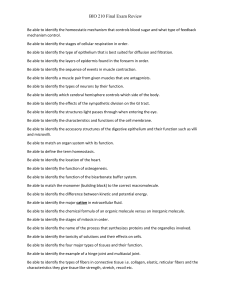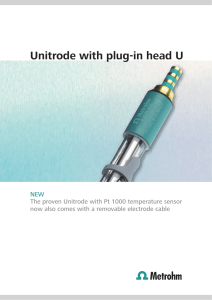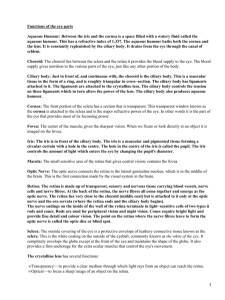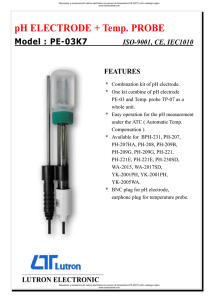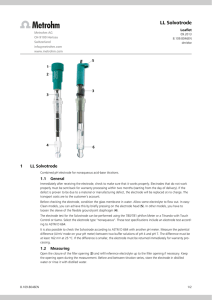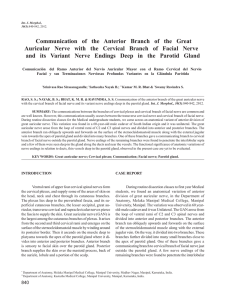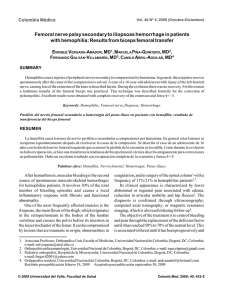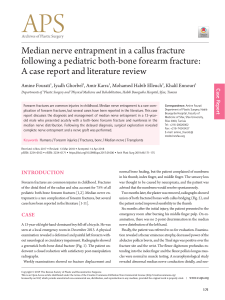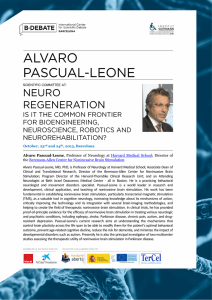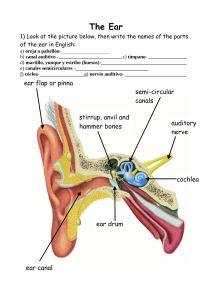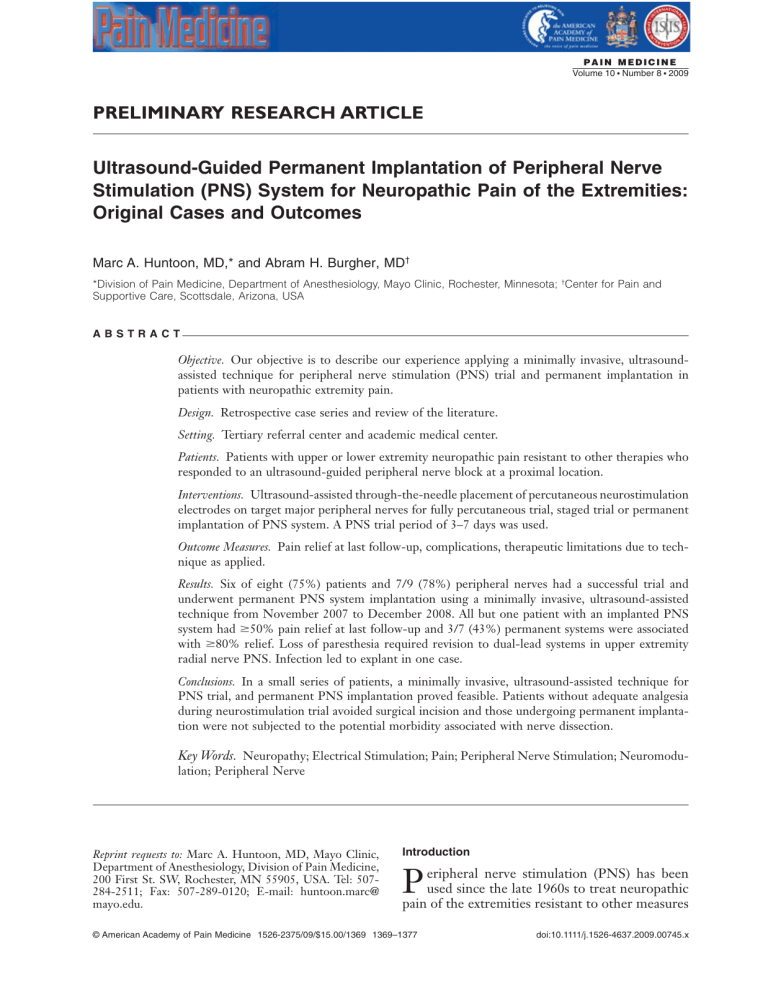
PAIN MEDICINE Volume 10 • Number 8 • 2009 PRELIMINARY RESEARCH ARTICLE Ultrasound-Guided Permanent Implantation of Peripheral Nerve Stimulation (PNS) System for Neuropathic Pain of the Extremities: Original Cases and Outcomes pme_745 1369..1377 Marc A. Huntoon, MD,* and Abram H. Burgher, MD† *Division of Pain Medicine, Department of Anesthesiology, Mayo Clinic, Rochester, Minnesota; †Center for Pain and Supportive Care, Scottsdale, Arizona, USA ABSTRACT Objective. Our objective is to describe our experience applying a minimally invasive, ultrasoundassisted technique for peripheral nerve stimulation (PNS) trial and permanent implantation in patients with neuropathic extremity pain. Design. Retrospective case series and review of the literature. Setting. Tertiary referral center and academic medical center. Patients. Patients with upper or lower extremity neuropathic pain resistant to other therapies who responded to an ultrasound-guided peripheral nerve block at a proximal location. Interventions. Ultrasound-assisted through-the-needle placement of percutaneous neurostimulation electrodes on target major peripheral nerves for fully percutaneous trial, staged trial or permanent implantation of PNS system. A PNS trial period of 3–7 days was used. Outcome Measures. Pain relief at last follow-up, complications, therapeutic limitations due to technique as applied. Results. Six of eight (75%) patients and 7/9 (78%) peripheral nerves had a successful trial and underwent permanent PNS system implantation using a minimally invasive, ultrasound-assisted technique from November 2007 to December 2008. All but one patient with an implanted PNS system had ⱖ50% pain relief at last follow-up and 3/7 (43%) permanent systems were associated with ⱖ80% relief. Loss of paresthesia required revision to dual-lead systems in upper extremity radial nerve PNS. Infection led to explant in one case. Conclusions. In a small series of patients, a minimally invasive, ultrasound-assisted technique for PNS trial, and permanent PNS implantation proved feasible. Patients without adequate analgesia during neurostimulation trial avoided surgical incision and those undergoing permanent implantation were not subjected to the potential morbidity associated with nerve dissection. Key Words. Neuropathy; Electrical Stimulation; Pain; Peripheral Nerve Stimulation; Neuromodulation; Peripheral Nerve Reprint requests to: Marc A. Huntoon, MD, Mayo Clinic, Department of Anesthesiology, Division of Pain Medicine, 200 First St. SW, Rochester, MN 55905, USA. Tel: 507284-2511; Fax: 507-289-0120; E-mail: huntoon.marc@ mayo.edu. Introduction P eripheral nerve stimulation (PNS) has been used since the late 1960s to treat neuropathic pain of the extremities resistant to other measures © American Academy of Pain Medicine 1526-2375/09/$15.00/1369 1369–1377 doi:10.1111/j.1526-4637.2009.00745.x 1370 [1,2]. Unlike spinal cord stimulation (SCS), for which a minimally invasive percutaneous technique is frequently used for both trial and permanent implantation, no such technique has been widely available for PNS. Currently, the only commercially available peripheral stimulation lead has a flat paddle-shape, which is not amenable to placement via a minimally invasive approach. PNS trial and implantation each require dissection of the target nerve from surrounding tissues and placement under direct vision of the electrode [3]. Because even a PNS trial can only be performed after sometimes extensive surgical incision and skeletonization of the target nerve, patients demonstrating poor early response must still undergo a procedure with significant morbidity [2]. Development of a minimally invasive technique for PNS electrode placement would therefore have the potential to improve patient selection and reduce morbidity associated with PNS. We hypothesized that analgesic neurostimulation of major peripheral nerves of the extremities could be achieved using standard percutaneous epidural electrodes. These electrodes were not designed with peripheral nerve targets in mind, but they have been used successfully for occipital and supraorbital nerve stimulation, and peripheral field stimulation [4,5]. In cases of occipital and supraorbital nerve stimulation the electrode array is typically oriented perpendicular to the nerve, resulting in paresthesiae in the nerve’s cutaneous distribution, whereas for peripheral field stimulation the electrode is implanted subcutaneously within the painful area. Using a cadaver model we previously developed a minimally invasive, ultrasound-assisted technique to place neurostimulation electrodes designed for SCS in close proximity and perpendicular to extremity peripheral nerves [6,7]. Ultrasound made possible real-time visualization of needle advancement and electrode deployment to within 2–3 millimeters of target nerves. Development of this technique allowed us to perform minimally invasive and in some cases fully percutaneous PNS trials in a small group of patients, a majority of whom went on to permanent implantation of a PNS system using the same ultrasoundassisted technique. Our technique has the potential to increase the appeal of PNS among physicians and patients alike, and expand the therapy to a larger segment of the chronic pain patient population. Huntoon and Burgher Methods After institutional review board approval, we retrospectively reviewed the medical records of all patients who underwent a minimally invasive peripheral neurostimulation trial for neuropathic pain of a major peripheral nerve of the upper or lower extremity. Patient Selection All patients had failed more conservative treatment measures and had probable neuropathic or mixed neuropathic and nociceptive pain as supported by one or more of the following descriptors commonly associated with neuropathic pain: hot or burning character; prickling, tingling, pins and needles; electric shocks or shooting; numbness; or pain evoked by light touch [8]. Patients had pain isolated to a single major peripheral nerve as evidenced by >80% pain relief with ultrasoundguided nerve block of the target nerve at a proximal location. (e.g., a patient with neuropathic symptoms in the distribution of the superficial cutaneous branch of the radial nerve underwent radial nerve block at the mid-humerus.) Proper blockade was verified by expected sensory impairment or elimination of allodynia when possible to assess clinically. In addition, in all cases further operative intervention, e.g., neurectomy, was not indicated as determined by an orthopedic surgeon or neurosurgeon with expertise in peripheral nerve surgery. General Trial and Implant Technique All peripheral neurostimulation trials and permanent implantations were carried out in a traditional air exchange operating room and after the administration of appropriate perioperative antibiotics. Using a either a GE LOGIC e (General Electric Healthcare, Waukesha, WI) or Toshiba Nemio XG Model SSA-580A (Toshiba Medical Systems Corp., Tochigi-ken, Japan ultrasound machine) ultrasound machine, the target peripheral nerve was identified in a standard location (see “Approaches to Specific Nerves” below). After infiltration of the skin and superficial subcutaneous tissues with local anesthetic, a 3–5 millimeter skin nick was made with a surgical blade. A short axis cross sectional image of the nerve was obtained with ultrasound and a standard 14 gauge epidural needle (Boston Scientific, Valencia, CA; or Medtronic, Minneapolis, MN) was advanced in the imaged plane through skin and subcutaneous tissues to lie transverse and in close proximity to Percutaneous Implantation of PNS 1371 Figure 1 In the upper panel, the upper extremity is seen at a position approximately 10–14 cm proximal to the epicondyles. The ultrasound probe is oriented in the transverse plane to show the nerve in cross-section. (A) Large block arrows outline the ulnar nerve. The small arrows show the 14-gauge needle placed deep to the nerve (medial). (B) In this view, the electrode is just starting to emerge from the needle tip. (C) In this view, the full eight contact electrode is in position, and the needle is being retracted. The small arrows show both the needle, and the individual contacts of the electrode. The larger arrows show the hypoacoustic shadow of the humerus, as well as the ulnar nerve just superficial to the electrode. (D) This line drawing replicates the image in Figure 1C. the target nerve, usually inferior (deep) to the nerve with its tip a few millimeters beyond the nerve (Figure 1). As ultrasound permitted discrimination of adjacent tissue types and in some cases fascial planes between adjacent muscles, care was taken whenever possible to avoid needle passage directly through large volumes of muscle. A standard 8-contact percutaneous epidural neurostimulation electrode (Boston Scientific or Medtronic) was then deployed through the needle until it met with resistance. The needle was withdrawn under live ultrasound to reveal the electrode with its array perpendicular to the nerve. The electrode was maneuvered to a final location in which the middle contacts of the electrode were in closest proximity to the nerve (i.e., some contacts were beyond the nerve, some crossed the long-axis of the nerve and the remainder were located on the opposite side of the nerve). In some cases a second electrode was placed in the same 1372 fashion to lie <1 cm apart from and parallel to the first electrode. Perpendicular placements relative to the nerve were used to allow for continued satisfactory neurostimulation in the case of minor lead migration and to account for the natural translational movement of nerves relative to other tissues of the extremity. After stimulation verified paresthesiae in the distribution of the target nerve, the electrode(s) was anchored. In cases of fully percutaneous trials, anchoring was at the skin. For staged trials, a 4–6 cm incision was made and dissection carried down along the path of the electrode(s) to expose superficial fascia. Electrodes were secured at this fascial plane using knobby anchors available in the kit (Boston Scientific or Medtronic). Strain loops were created at the anchoring site and temporary lead extensions tunneled to a skin exit site more than 10 cm away. For both fully percutaneous and staged trials, a period of 3–7 days ensued, during which time frequent contact with our nursing staff was used to ensure optimal programming during the trial and appropriate evaluation of neurostimulation efficacy. In cases of successful staged trial (>50% relief of typical pain), for permanent implantation, temporary lead extensions were removed and the existing electrode(s) was tunneled to an implantable pulse generator (IPG). For permanent implantation in cases of fully percutaneous trial, the permanent neurostimulation electrode(s) was placed in identical fashion to the trial. In this case, however, after proper electrode position was verified, the lead(s) was anchored as above for staged trials. Pulse generator pockets were located on the upper chest or abdomen for upper extremity PNS, or the lateral thigh or calf for lower extremity PNS. Approaches to Specific Nerves Placement of neurostimulation electrodes at each of the target nerves was performed using an approach similar to that described in our study using cadaver specimens [6,7]. Exceptions are noted. Median The median nerve was identified at a point approximately 6 cm proximal to the medial epicondyle. Approach to this nerve differed from that previously described in our cadaver model because of concerns for migration when the PNS system crosses two major joints [6]. Ultrasound scanning began at the elbow, and with the probe in a transverse orientation to the arm, continued proximally until the desired approach was identified. Location Huntoon and Burgher of the brachial artery was noted to avoid vascular puncture during electrode placement. The needle was advanced from antero-medial to posteromedial to lie between nerve and humerus. Care was taken to minimize trauma to surrounding tissues, but needle passage was through the short head of the biceps brachii muscle in all cases. The electrode(s) was anchored in superficial fascia of the biceps muscle. Radial The radial nerve was identified at a point 10–14 cm proximal to the lateral epicondyle, a location in which it was usually easily identifiable and in close proximity to the humerus. The radial nerve is scaphoid in appearance here and close to the humeral bone surface. Ultrasound scanning usually began at the elbow, and with the probe in a transverse orientation to the arm, continued proximally until the desired approach was identified. The needle was advanced from postero-lateral to antero-medial to lie between nerve and humerus. Care was taken to minimize trauma to surrounding tissues, but needle passage was inevitably through at least one head of the triceps muscle, usually the lateral head. The electrode(s) was anchored in superficial fascia of the triceps muscle. Ulnar The ulnar nerve was identified at a point 9–13 cm proximal to the medial epicondyle in the posterior arm, a location in which it was usually easily identifiable and in close proximity to the humerus. Ultrasound scanning usually began at the elbow, and with the probe in a transverse orientation to the arm, continued proximally until the desired approach was identified (see Figure 1 top panel). The needle was advanced from posterior to anterior on the medial aspect of the arm to lie between nerve and humerus. Needle approach differed from that described in our cadaver model because we chose to tunnel along the posterior aspect of the arm to accommodate tunneling through the posterior axilla and eventually to a pulse generator site in the abdomen. Care was taken to minimize trauma to surrounding tissues, but needle passage was inevitably through at least one head of the triceps muscle, usually the medial head. The electrode(s) was anchored in superficial fascia of the triceps muscle. Peroneal The common peroneal nerve was identified at its branch point from the sciatic nerve, a point 6–12 cm proximal to the popliteal crease. Ultra- Percutaneous Implantation of PNS sound scanning usually began at the popliteal crease, and with the probe in a transverse orientation to the leg, continued proximally until the desired location was identified. Location of the popliteal artery was noted to avoid vascular puncture during electrode placement. The needle was advanced from postero-lateral to antero-medial to lie just deep to the bifurcation of the sciatic nerve and a short distance beyond the tibial branch before deploying the electrode. Care was taken to minimize trauma to surrounding tissues and in all cases needle passage through muscle was avoided. The electrode was anchored in superficial fascia of the biceps femoris muscle. Posterior Tibial The posterior tibial nerve was identified at a point 8–14 cm proximal to the medial malleolus. Ultrasound scanning usually began at the ankle, and with the probe in a transverse orientation to the leg, continued proximally until the desired approach was identified. Location of the posterior tibial artery was noted to avoid vascular puncture during electrode placement. The needle was advanced from anterior to posterior along the medical aspect of the ankle to lie just superficial to the nerve. Care was taken to minimize trauma to surrounding tissues and needle passage through muscle was avoided in all cases. The electrode was anchored in superficial fascia of the medial gastroc-soleus musculature. Results Eight patients met inclusion criteria from November 2007 to December 2008 (Table 1). Six of eight (75%) patients (and seven of nine target nerves; 78%) had successful trial neurostimulation and underwent permanent PNS implantation. The two patients not undergoing placement of a permanent system avoided surgical incision as the trial was fully percutaneous. Of these two patients, one had previously failed a “paddle” electrode PNS system targeting the same nerve; the other had excellent paresthesia coverage of the painful area, but the stimulation was not analgesic. In four of six patients undergoing permanent implantation, trial electrodes were anchored in a staged fashion as neurostimulation was clearly analgesic in the operating room immediately after placement. One patient (#2) had bilateral upper extremity PNS systems implanted; the second permanent system was fully implanted at the time of initial electrode placement after verification of analgesia. 1373 Five of six (83%) patients undergoing permanent PNS implantation had ⱖ50% pain relief at last follow-up (range = minimal to 100%). Follow-up was ⱖ8 months in 5/7 (71%) permanent PNS systems implanted and ⱕ2 months in the remaining 2/7 (29%). Despite our clinical sense that PNS applied to mixed motor and sensory nerves has a narrow therapeutic window, for only 2/7 (29%) permanent systems did motor stimulation clearly limit efficacy. The first three upper extremity PNS systems we implanted initially utilized only a single lead, but later were revised to dual-lead systems after loss of paresthesia. Paresthesia loss did not occur in any case in which a dual-lead system was in use. Singlelead systems were implanted in all lower extremity cases with no loss of paresthesia during follow-up. One patient (patient #3) had an infection which appeared to center on the electrode anchoring site and the entire system was explanted. After 4 weeks and in consultation with the infectious disease service at our institution, an identical PNS system was re-implanted. This patient was a staphylococcus carrier and was treated with a 1-week course of intranasal mupirocin prior to reimplantation. In another case (patient #1) a small wound dehiscence required only minor debridement. Stimulation parameters were as follows. Intensity settings for patients #3, #4, #7, and #8 ranged from 1.4 to 10.4 milliamps. Intensity settings for patients #1 and #2 were 0.7 to 3.6 V. (Patients #1 and #2 received Medtronic systems, and as pulse generators from this company operate on a constant voltage protocol, intensity settings are reported in volts. All other patients received Boston Scientific systems, which operate on constant current.) Efforts were made during programming to find the lowest stimulation intensity that still produced analgesia, and in all cases but one (Patient #1) stimulation below perceptible levels for paresthesia still produced analgesia. Pulse width ranged from 130 to 490 ms with no clear association to nerve stimulated. Frequency ranged from 40 to 90 Hz. Utilization of only a select number of contacts (2–5) along a short distance of electrode was found to produce maximum analgesia with minimum motor stimulation and unpleasant paresthesiae. In no case was more than 2 anodes used, which is consistent with our observation that all peripheral nerves treated had a smaller diameter than the spacing between opposite ends of two adjacent contacts (both for the 8-contact electrode from Boston Scientific and the 8-contact Sub Compact electrode from Medtronic). Radial (left) Ulnar Posterior tibial Median Ulnar Common Trauma peroneal Common Trauma peroneal 2b 3 4 5 6 7 8 Trauma; Failed surgery Failed carpal tunnel release (bilateral) Traumatic sciatic nerve injury Elbow trauma; failed ulnar nerve transposition Chronic lateral epicondylitis (left); failed radial nerve exploration at elbow (left) Chronic lateral epicondylitis (right); failed radial nerve exploration at elbow (right) Radial (right) 2a Painful symptoms 2 years 8 years 6 years 6 years 21 months Burning, sharp Burning, constant, sharp Burning, constant, sharp, aching 3 years 8 years approx. 7 years 12/16/08 9/18/08 12/2/08 11/6/07 11/7/07 6/30/08 4/9/08 1/29/08 12/17/07 70% 60% 0% 0% 80% 80% N/A 80% 100% Y Y N N Y Y Y Y Y Positiondependent stimulation of permanent system (Y/N) Lateral thigh Lateral thigh N/A N/A Medial calf N N N/A N/A N Ipsilateral N abdomen Ipsilateral Y anterior chest Ipsilateral Y anterior chest Ipsilateral Y anterior chest Pain relief Permanent Pulse Duration of during implantation generator symptoms Trial date trial (Y/N) site Dull, 14 years dysesthetic tingling Burning Stabbing, burning, allodynia Aching, stinging, allodynia (left) Aching, stinging, allodynia (right) Wrist injury; failed Burning at superfical radial dorsum of neurectomy wrist and thumb Radial 1 Probable etiology of neuropathic pain Patient characteristics and outcomes Target Patient nerve Table 1 N N N/A N/A N N N Y Y 0 0 N/A N/A 0 2 2 2 3 Pain relief after implant (last follow-up) 50% Y Y Y 2 months <1 month N/A N/A 14 months 50% 80% N/A N/A 60% N Y N/A N/A N/A None None None N N Infection requiring explantation Irritating IPG site requiring pocket revision Irritating IPG site requiring pocket revision Minor wound dehiscence requiring exploration and closure of IPG incision; irritating IPG site requiring pocket revision Medication reduction at last follow-up (Y/N) Complications 8 months approx. 80% Y 10 months 100% 13 months 14 months Minimal Motor stimulation limited Number Time efficacy of to last (Y/N) revisions follow-up Single lead; more reduction in frequency of worsening painful episodes than in overall pain intensity Staged trial; single lead; limited follow-up 65% relief with pre-trial nerve block No preoperative test block of target nerve; Indwelling contralateral paddle electrode for median PNS at time of initial consultation; previous failed PNS at target nerve with paddle electrode; failed SCS Staged trial; single lead Dual lead; reimplantation of same system after infection cleared; last follow-up is time from implantation of original system No trial; late loss of paresthesia requiring revision to dual-lead system; second revision for loss of paresthesia Staged trial; late loss of paresthesia requiring revision to dual-lead system; second revision for loss of paresthesia Staged trial; early loss of paresthesia requiring revision to dual-lead system Notes 1374 Huntoon and Burgher Percutaneous Implantation of PNS Discussion In a small group of patients with neuropathic pain in the distribution of a major peripheral nerve a minimally invasive, ultrasound-assisted PNS trial, and implantation technique proved feasible. Seventy-five percent of patients undergoing trial proceeded to implantation of a permanent PNS system. Outcomes were consistent with the upper range of outcomes of published studies using an open surgical technique, with pain relief ⱖ50% at last follow-up in all but one patient with an implanted PNS system [9]. Patients in our series who underwent trial but did not go on to permanent implantation avoided surgical incision and those who had a permanent PNS system implanted were spared the potential morbidity associated with dissection of the nerve from surrounding tissues. Previous reports of PNS for extremity neuropathic pain include case series and case reports, but no randomized, controlled trials. Nashold et al. performed open surgical PNS of 39 major peripheral nerves in 35 patients with neuropathic pain of the extremities [10]. Selection criteria were similar to ours and included positive response to nerve block at a proximal level. Most patients had a partial response to transcutaneous electrical nerve stimulation (TENS) prior to PNS implantation, but the details surrounding this are not clear. Unlike our series, no trial of PNS was performed prior to proceeding to permanent implant. After surgical incision and nerve dissection under local anesthesia, intraoperative sensory mapping of the target nerve was performed and small button electrodes were sewn to the epineurium in regions with high density of sensory axons. Outcomes were successful (>90% pain relief, increase in activity, abstinence from pain medications) in 53% of patients with upper extremity PNS and 31% with a lower extremity system. In our series, 3/7 (43%) patients with permanent systems had ⱖ80% relief at last follow-up. All but one of our patients experienced a reduction in pain medication intake, while one patient eliminated analgesic medications altogether. Other, more recent studies of extremity PNS using an open surgical approach to place flat “paddle” or “plate” electrodes noted benefits similar to those seen in our series. Mobbs et al. (2007) reported a case series of 38 patients (with 41 nerve stimulators) who underwent PNS [3]. Sixtyone percent of patients had ⱖ50% pain relief with average follow-up duration slightly less than 3 1375 years. Like the Nashold et al. study, there was distinctly greater efficacy with upper extremity systems relative to those for lower extremity pain [10]. Hassenbusch et al. described results after permanent PNS placement in 30 patients with complex regional pain syndrome (CRPS) [11]. Sixty-three percent of patients had good or fair relief and among those patients relief persisted during average follow-up of more than 2 years. Average reduction in pain relief among all patients in the Hassenbusch et al., series was just over 50% with spontaneous pain and allodynia particularly impacted [11]. There were no patients with a diagnosis of CRPS in our study, though neuropathic pain descriptors of patients in our series overlapped with those in the Hassenbusch et al. study [11]. There was no clear efficacy difference in our series between upper and lower extremity PNS, though in all lower extremity cases satisfactory stimulation was achieved with a single lead, while upper extremity systems seemed to require dual leads. This differs from previous reports, in which lower extremity PNS was associated with poorer efficacy [3,10]. Nashold et al. postulate that the relatively poorer efficacy seen in their lower extremity patients may be due to anatomic constraints imposed by the neural target [10]. All lower extremity patients in the Nashold et al. series underwent PNS of the sciatic nerve at a proximal location, where depth of sensory fibers relative to the surface of the nerve may make neurostimulation difficult. In contrast, we chose to stimulate branches of the sciatic nerve at either the sciatic bifurcation in the popliteal fossa or along the posterior tibial nerve in the medial calf. It may be that the smaller diameter of the peripheral nerve targets at these locations permitted improved capture of sensory fibers. Mobbs et al. theorize an additional factor contributing to poor efficacy in lower extremity PNS systems may be that the posterior tibial nerve is particularly sensitive to traction with weightbearing, resulting in movement of the nerve relative to the implanted electrode [3]. It is possible that our technique allows freer movement of electrode relative to nerve and surrounding soft tissues with movement and weightbearing with “recapture” of the original configuration when movement ceases. Additional factors contributing to the high success rate in our lower extremity patients could include less perineural scarring with our percutaneous electrodes relative to flat electrodes and a more forgiving neurostimulation field as the field created in a percutaneous system is less directional. 1376 Interestingly, some data suggest that PNS efficacy remains stable or even improves over time [10,12]. Follow-up in the Nashold et al. study was longer than ours, ranging from 4 to 9 years, and it appeared in that study that patients required shorter duration of stimulation as time passed. Data from Long et al. also suggest improved PNS efficacy over time [10,12]. It is difficult to know if this would be true were our patients to be followed for longer, but in our short-term observation we found no consistent decline in efficacy. One patient (#1) did have analgesia limited by motor stimulation, and in that patient even the limited efficacy that was obtained fell over time. Interestingly, all patients but one (#1) achieved analgesia at stimulation intensity below perceptible threshold for paresthesia. This has not been reported in previous series of PNS. In our practice, the nursing staff has extensive experience with neuromodulation programming and performs virtually all programming modifications. Given our understanding as a practice that PNS was likely to be associated with a narrow therapeutic window, our nurses worked to find the lowest possible stimulation intensity which produced analgesia. PNS revision operations occur for a variety of reasons, namely migration of electrodes, hardware resulting in discomfort, infection, hardware failure, among others. In the study by Nashold et al., in which small button electrodes were sewn to the epineurium of the target nerve, there were 31 total revisions in 35 patients, with a slight propensity for revision in the lower extremity [10]. In a large, unpublished series from Cleveland Clinic in which flat “paddle” electrodes were used, 1.6 revisions occurred per patient treated [13]. More recent series continue to suggest revision is common, with rates of 0.5–1 per patient [3,11]. Revisions in these more recent studies were most commonly for lead migration and hardware failure. Revisions occurred primarily early in our series, as we were still becoming familiar with the technique as applied to patients rather than our cadaver model. Revisions totaled 9 in 7 permanent systems implanted, a rate of 1.3 per patient. Revisions for loss of paresthesia required conversions from single to dual-lead systems targeting the radial nerve. In our series no lower extremity system required revision, even though all three lower extremity permanent PNS implants were with a single electrode. In each case of revision the pulse generator had been implanted a great distance from the electrode anchoring site and Huntoon and Burgher crossed at least one major joint. However, in lower extremity placements, the pulse generator was implanted in the same anatomical area without crossing a major joint. These placements and their long term stability suggest that there is less traction on the leads when the pulse generator can be placed a short distance from the lead anchoring sites. The technique for tunneling and pulse generator implantation is not described in detail in the Mobbs et al. series but it seems that lower extremity PNS systems in the study crossed a major joint, a distinct difference from our lower extremity technique [3]. Location of the pulse generator relative to electrode in the Hassenbusch et al. study is not reported [11]. Patients in the Nashold et al. series underwent implantation of a radiofrequency receiver since the first IPG was not available until 1983 [10]. The receiver was implanted a great distance from the electrodes. Complications in our series in addition to loss of paresthesia requiring revision included infection and poor wound healing. In one case (patient #3) infection necessitated device explant and in another a small dehiscence required wound revision. There were no major complications, such as nerve injury. Previous reports define complications variably, some including revision and others not. Our complication rate was 29% (not including revision for loss of paresthesia), which falls within the range noted by other studies (5 to 43%) [9]. An unknown is how our technique will impact complications related to [1] long-term residence of a flat electrode directly on the target peripheral nerve (or in some cases with a small layer of fascia between electrode an nerve) and [2] dissection of the nerve from surrounding tissues. These complications have included nerve scarring, injury to the nerve during implantation, reaction to implanted material and nerve ischemia due to electrodes which are too tightly affixed to the nerve [9]. Limitations of this study include its observational, retrospective design, and follow-up of short duration. In addition, data regarding efficacy and complications of patients treated earlier in our series are not necessarily comparable to those treated later, as we modified our technique as time passed by placing dual-lead systems in the upper extremity and minimizing the distance from electrode anchoring site to pulse generator. While patients were evaluated with regard to pain and functional status at clinical visits after PNS implantation, only pain scores were recorded consistently and in a manner that can be reported in a scientific manuscript. Nevertheless, our goals for Percutaneous Implantation of PNS this report were to describe our initial experience with an innovative technique, not to provide “gold-standard” evidence for long-term efficacy of PNS. Therefore, we do not believe these limitations reduce the significance of this study. PNS is a technique which to date has evidence of low quality supporting its use. Because of difficulties in patient selection, many have abandoned the technique. Future directions for PNS should include improvements in technique and technology, in addition to gaining a better understanding of long-term efficacy through high quality evidence. Limitations in currently available technology necessitate off-label use of products designed for spinal use or open surgical placement of electrodes after nerve dissection with no opportunity for minimally invasive trial. Future trials of PNS should consider innovative study design incorporating a sham control. Minimally invasive techniques which may be associated with lower morbidity may decrease perceived ethical barriers to trials with a sham procedure group. References 1 Wall PD, Sweet WH. Temporary abolition of pain in man. Science 1967;155(758):108–9. 2 Weiner RL. Peripheral nerve neurostimulation. Neurosurg Clin N Am 2003;14(3):401–8. 3 Mobbs RJ, Nair S, Blum P. Peripheral nerve stimulation for the treatment of chronic pain. J Clin Neurosci 2007;14(3):216–21; discussion 222–3. 4 Slavin KV, Colpan ME, Munawar N, Wess C, Nersesyan H. Trigeminal and occipital peripheral nerve stimulation for craniofacial pain: A singleinstitution experience and review of the literature. Neurosurg Focus 2006;21(6):E5. 1377 5 Paicius RM, Bernstein CA, Lempert-Cohen C. Peripheral nerve field stimulation in chronic abdominal pain. Pain Physician 2006;9(3):261– 6. 6 Huntoon MA, Hoelzer BC, Burgher AH, Hurdle MF, Huntoon EA. Feasibility of ultrasound-guided percutaneous placement of peripheral nerve stimulation electrodes and anchoring during simulated movement: Part two, upper extremity. Reg Anesth Pain Med 2008;33(6):558–65. 7 Huntoon MA, Huntoon EA, Obray JB, Lamer TJ. Feasibility of ultrasound-guided percutaneous placement of peripheral nerve stimulation electrodes in a cadaver model: Part one, lower extremity. Reg Anesth Pain Med 2008;33(6):551–7. 8 Bennett MI, Attal N, Backonja MM, et al. Using screening tools to identify neuropathic pain. Pain 2007;127(3):199–203. 9 Gybels JM, Nuttin BJ. Peripheral nerve stimulation. In Loeser JD, ed. Bonica’s Management of Pain, 3rd edition. Philadelphia, PA: Lippincott Williams and Wilkins; 2001:1851–6. 10 Nashold BS, Jr., Goldner JL, Mullen JB, Bright DS. Long-term pain control by direct peripheralnerve stimulation. J Bone Joint Surg Am 1982;64(1): 1–10. 11 Hassenbusch SJ, Stanton-Hicks M, Schoppa D, Walsh JG, Covington EC. Long-term results of peripheral nerve stimulation for reflex sympathetic dystrophy. J Neurosurg 1996;84(3):415–23. 12 Long DM. Electrical stimulation for relief of pain from chronic nerve injury. J Neurosurg 1973;39(6):718–22. 13 Stanton-Hicks M, Rauck RL, Hendrickson M, Racz G. Miscellaneous and experimental therapies. In Wilson PRS-HM, Harden RN, eds. CRPS: Current Diagnosis and Therapy, Progress in Pain Research and Management, vol. 32. Seattle, WA: IASP Press; 2005:255–74.
